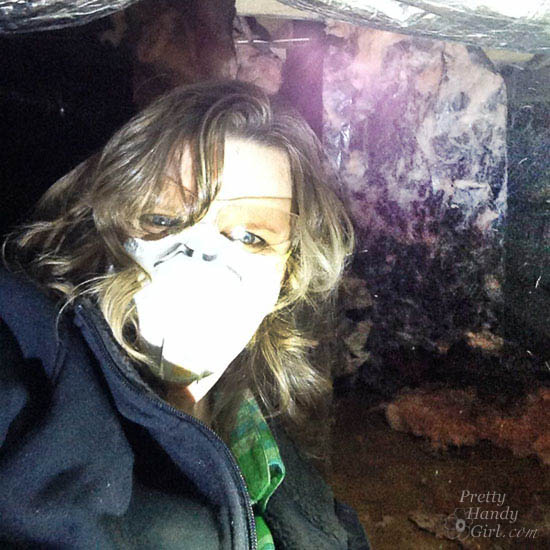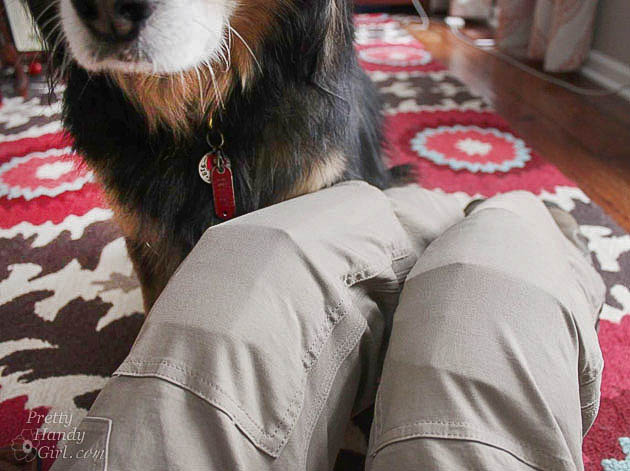Is Your Home’s Insulation Ready for Winter?
The folks at Duluth Trading Company want you to stay warm and comfortable this winter. They have sponsored this post to help you get your home ready for winter. And to help you stay warm and comfortable while taking on these energy conserving tasks.
Winter is fast approaching and now is the time to check the condition of your insulation. If you have a crawlspace and/or an attic, take a few minutes to check for any fallen or missing insulation. Last summer, my neighbor’s cat had a field day in our crawlspace. Luckily I found him before he was harmed. But, unfortunately he had done a fair amount of damage to the insulation in our crawl space.

Not a big deal, I was able to fix and replace the insulation within half an hour. I’m no stranger to our crawlspace. I have my go to gear when I need to go under the house.

I know a lot of people would sooner poke their eyes out than venture under the house. But, I can honestly tell you that I’ve only seen one creature underneath our house and he was eager to run away from me. If it makes you feel better you can prepare before you go. Here are a few things you’ll want to have and wear:
- A Hat (if you are squeamish about cobwebs)
- Gloves are a must when working with insulation
- Cargo pants with knee pad pockets
- Knee pads
- Long sleeve shirt to cover your arms
- Shoes that can be easily brushed off
- Flashlight that can be propped up
- Utility Knife
Materials for Installing Insulation:
(I’ve included affiliate links for your convenience. I earn a small percentage from a purchase using these links. There is no additional cost to you. You can read more about affiliate links here.)

About Insulation and R-Values:
Don’t know what type of insulation or R-value to use? This article from Lowe’s is a great resource. Here’s a handy chart to help you determine what R-value you need for specific areas of your home.
The most common spacing between studs, rafters and joists is 16″. Take note if your spacing is wider because you’ll need to buy insulation to accommodate your widths.
When installing insulation batts and rolls, the paper side must face the living space. In the attic the paper will face in. In the crawlspace, the paper will face the subfloor.
How to Install and Replace Insulation Batts or Rolls:
If you are headed to the crawlspace, pull out those knee pads!

I’ve used many types of knee pads over the years and these insert knee pads that slip into the pockets on the Duluth Fire Hose Cargo Pants do not slip down and don’t have to be re-adjusted. They are the bomb!

If your insulation has fallen but is still in good condition, all you need to do is wedge an insulation support between the rafters or floor joists. Don’t crush the insulation. The fluffier it is, the better the insulating factor.
If you are missing batts of insulation or need to replace pieces that are in bad shape, start by measuring the length of the space.

Cut the batt to size.

Make sure your utility knife is sharp and make multiple cuts until you have cut all the way through the insulation.
Fit the insulation in the space. Use the staple gun to secure the paper wings to rafters in the attic. In the crawlspace, use insulation supports to hold the insulation against the subfloor.

What are you waiting for? A snow storm? Get moving and make sure your home is warm and energy efficient this season.
While you’re at it, make sure you have your own personal insulation with a super warm parka (the absolute warmest winter coat I’ve ever owned) and hats, gloves and sweaters from Duluth Trading Company.
Disclosure: This post was sponsored by Duluth Trading Company. I can honestly say that this is a brand I’ve been thrilled to work with because their clothing is made to withstand tough conditions. I was not told what to say or write. I will always let you know if you are reading a sponsored post.
Pin for later!










You do your own maintenance to know this. This is something that homeowners must not take for granted if you want to have a safer place for you and your family during winter.
Attic – be careful in the attic. You may have mentioned this and I missed it. But your photo looks as though you are insulating an exterior wall. Specifically, it looks like the roof. The problem you will get there is most houses have ridge vents. When you insulate between the roof joist, you restrict the airflow from the soffit vent to the ridge vent. This can cause roof damage. You should be actually insulating the floor that you’re walking on in the attic , ie the ceiling joists.
Sorry, didn’t mean to but in. Great site – thanks.
You are absolutely correct. I was so anxious to get the insulation in, I forgot to put in the baffle in that channel. Not sure why that one was missing because the other sections do have baffles. Thanks for your comment.
Britanny
This is a BRILLIANT post.
I laid all the new insulation in my walls this past winter in my kitchen as I also learnt to drywall. It didn’t exactly look professional, but I felt like a legend when I was finished.
Thanks for empowering more women to just ‘have a go’.
<3
Pia
We don’t need to worry about winter much here in Arizona but for summer, well, that’s another story. We have never turned on the heat here during the winter. I know hard to believe, but I just don’t get that cold in my house during our winter. Of course outside it’s a desert cold at night but not my most other peoples standards. I love those Duluth clothes btw, pretty cool working duds.